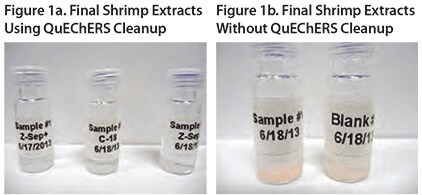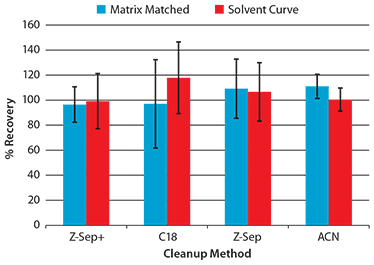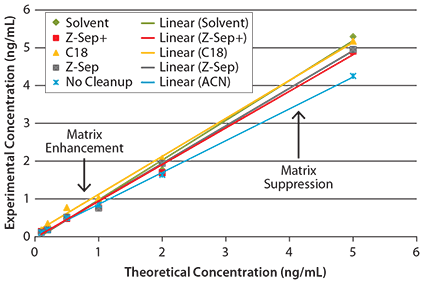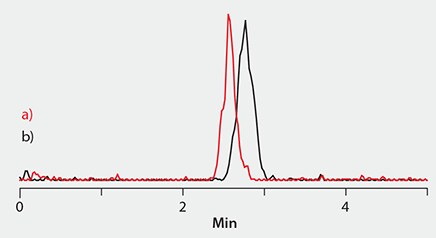Fast Extraction and Low Level Detection of Chloramphenicol in Shrimp
Emily Barrey, Olga Shimelis, Michael Halpenny, Jennifer Claus
Reporter US Volume 32.1
QuEChERS Sample Preparation Using Z-Sep+ Sorbent and Analysis by Ascentis® Express C18 LC-MS/MS
Introduction
Chloramphenicol is a broad spectrum antibiotic that has been determined as a causative agent of aplastic anemia and possible carcinogen in humans. These health concerns prompted a ban on the use of chloramphenicol in animal products including farmed fish and shrimps. As of today, a “zero” tolerance level has been established for this antibiotic; however, the drug is still widely available in developing countries, and no “safe” residue levels have been determined in food1. Therefore, a highly selective and sensitive analytical assay to control and monitor chloramphenicol residues in difficult matrices, such as food stuffs, is needed.
The QuEChERS (Quick, Easy, Cheap, Efficient, Rugged and Safe) technique is rapidly becoming a universal sample preparation approach for a variety of analyte classes and a variety of matrices2-4. In this study, several different QuEChERS sorbents were used in the sample cleanup procedure of shrimp samples prior to chloramphenicol analysis. Analyte recovery, reproducibility and ionization effects were compared.
Experimental
Frozen shrimp samples were homogenized, and 1 gram samples were extracted with 9 mL of acetonitrile. Samples were shaken and centrifuged. The supernatant was decanted, 90 µL of formic acid was added and the solution was mixed with 500 mg of appropriate dispersive sorbent: Z-Sep+, Z-Sep, C18 or no cleanup sorbent. Samples were shaken and centrifuged, then 8 mL of supernatant was evaporated to dryness and reconstituted with water.
Multiple replicates of both unspiked and spiked extracts at 0.3 ppb were processed. All samples were analyzed by LC-MS/MS using negative electrospray ionization (ESI). Resulting samples were quantified with the use of solvent calibration standards and a matrixmatched calibration curve to identify matrix effects.
Results
Figure 1 demonstrates the differences in pigment removal for the various sorbents. In Figure 1a, the lack of color in the extracts shows that Z-Sep+, C18 and Z-Sep all effectively removed pigment from the shrimp matrix. Also, as seen in Figure 1b, samples that were extracted without the application of a cleanup sorbent produced precipitation over time. Therefore, the use of QuEChERS sorbents is essential for the removal of both interfering pigments as well as solid matrix components in shrimp samples.

Figure 1.Comparison of Shrimp Extracts with and without QuEChERS Cleanup
Figure 2 charts the comparison of analyte recovery and percent relative standard deviation (%RSD) using matrix matched calibration standards and external solvent calibration standards. As illustrated, the overall chloramphenicol recoveries were within an acceptable range (greater than 97%) for the variety of cleanup methods used. However, as indicated by the error bars, Z-Sep+ gave more reproducible results than the other dispersive sorbents.

Figure 2.Analyte Recovery and %RSD Using Matrix Matched Calibration Standards and Solvent Curve (n = 4)
Figure 3 demonstrates the ionization effects for each cleanup procedure by deviation from the solvent calibration curve. Matrix suppression was evident for the acetonitrile extraction where QuEChERS cleanup was not performed. Matrix enhancement was observed for the C18 cleanup method. A chromatogram of a 0.3 ng/g chloramphenicol spiked shrimp sample is shown in Figure 4.

Figure 3.Matrix Ionization Effects by Deviation from Solvent Curve

Figure 4.LC-MS/MS Extracted-Ion Chromatogram (XIC) for a) Chloramphenicol in Shrimp Extract (0.3 ng/g) and b) Internal Standard in Shrimp Extract (0.6 ng/g)
HPLC Conditions
mobile phase: (A) water; (B) acetonitrile; gradient: 15% B for 0.1 min, 15–80% in 1.9 min, held at 80% for 1.5 min, 80–15% in 0.5 min, at 15% for 3 min; flow rate: 0.5 mL/min; pressure: 190 bar; detector: MS/MS, ESI(+), MRM, 320.9/151.9, 326/157; injection: 10 µL; sample: chloramphenicol or internal standard spiked at 0.3 ng/g in shrimp extract
Conclusion
A highly selective and sensitive analytical method was developed for chloramphenicol using a QuEChERS type sample preparation approach and LC-MS/MS detection. Samples extracted using the QuEChERS cleanup sorbents gave no ion suppression or sample precipitation over time. The QuEChERS cleanup using the Z-Sep+ sorbent produced acceptable recoveries and provided more reproducible results in comparison when using Z-Sep or C18 sorbents. Sufficient resolution and retention was achieved using a Fused-Core® Ascentis® Express C18 column with a very short run time. Therefore, the combination of the new cleanup sorbent Supel™ QuE Z-Sep+, Fused-Core technology and LC-MS/MS detection provided a fast and sensitive method for the low-level detection of chloramphenicol in shrimp.
Legal Information
Ascentis and Discovery are registered trademarks of Sigma-Aldrich Co. LLC
Supel is a trademark of Sigma-Aldrich Co. LLC
Fused-Core is a trademark of Advanced Materials Technology Inc.
References
如要继续阅读,请登录或创建帐户。
暂无帐户?